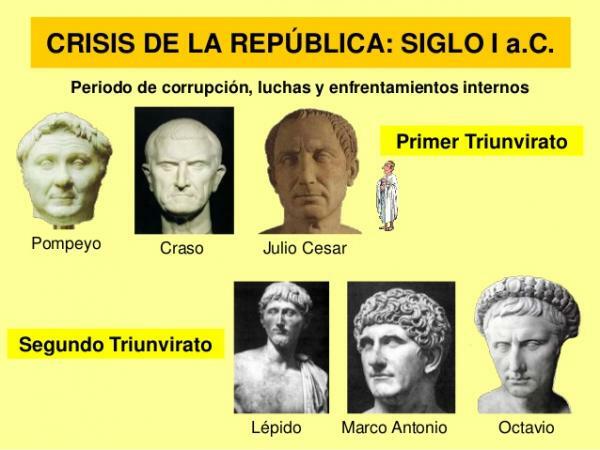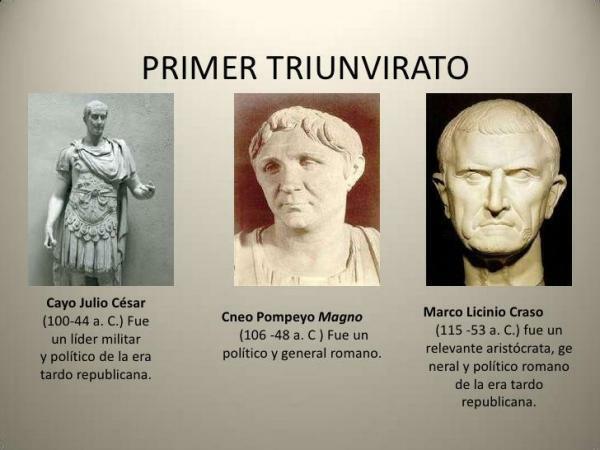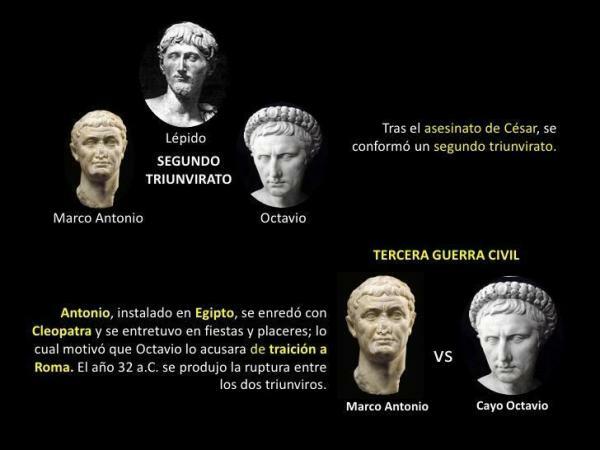First and Second Roman Triumvirate - Summary

Image: Slideshare
The name of triumvirate is a term that was already given in Ancient Rome to refer to a form of government carried out by three allied people among themselves, in charge of directing power. In the first triumvirate the political alliance was formed by Gaius Julius Caesar, Marco Licinius Crassus and Cneo Pompeyo Magno; and in the case of the second triumvirate, by Marco Antonio, César Octaviano and Marco Emilio Lépido. Next, in this lesson from a TEACHER we offer you a summary of the first and second Roman triumvirate, seeing only those most outstanding aspects.
The first triumvirate was made up of three of the Roman leaders of the time, Gaius Julius Caesar, Marco Licinius Crassus and Pompey the Great.
Already by the year 70 a. C. being consuls, Licinius Crassus and Pompey were in charge of repeal the aristocratic Constitution of one of the most notable dictators in the history of Rome, Lucio Cornelio Sila Félix.
On the one hand, Crass he fought tirelessly in the uprising of the slaves led by Spartacus
, since the slave trade was one of their main sources of income. On the other hand, Pompey, attacked the pirates in the Mediterranean, and faced several revolutionaries in Asia Minor, by which he obtained the nickname "Great." Both, they gained fame and returned with triumphant airs to the city of Rome. Julius Caesar, although he did not possess as much power as the previous ones, he allied with them, because he saw himself as a great skill in the political - military field.After this political alliance, Julius Caesar left to rule Gaul, Crassus towards Asia Minor, and Pompey stayed in Rome. Caesar, who needed some military campaign to gain popularity, succeeded in the Gallic war, earning the recognition of the Roman people. Meanwhile, in Rome, Pompey, is attracted by the senatorial conservative side, convincing him to finish off Caesar, since they believed that he would use his fame to establish himself as the only king.
Pompey from Rome ordered Caesar to return without his army, but Caesar realized that as soon as he arrived he would be tried and he condemned for carrying out said war without the permission of the Senate, and for recruiting more troops than he had allowed. Pompey and Julius Caesar never reached an agreement and decided to resolve the conflict with a long civil war in which Caesar ended up defeating Pompey in the Battle of Pharsalia (year 48 a. C.), who was later assassinated.
In all this time, Crassus died in the Battle of Carras and, with Pompey killed, the first triumvirate was put to an end.. Caesar took the lead in powerFor 10 years, however, the Senate side never gave up and ended assassinating him in the year 44 a. C. having among them senators whom Caesar himself pardoned in the war against Pompey.
That power vacuum was the reason for carrying out the Second Triumvirate.

Image: Slideshare
In the second triumvirate the alliance was made up of Marco Antonio, Marco Emilio Lépido and César Octaviano who were in charge of being in command of the government from the year 43 a. C.
That same year, and in order to restructure the politics of the Republic, the Triumviri Rei Publicae Constituendae Consulari Potestate, or what is the same, the Triumvirate for the Constitution of the Republic with Consular Power whose difference based on the The first triumvirate was that, rather than an alliance between politicians within the constitutional system, it was an association of three members whose sole purpose was to reconstitute the Republic, and for this they were assigned different areas of action, to Marco Emilio Lépido, Gaul Narbonense and Hispania, Marco Antonio, Gaul Cisalpina and César Octaviano Sardinia, Sicily and Africa.
During the first years, a series of riots were carried out in order to wipe out all the people who were involved in the assassination of Caesar, but over time they began to give internal confrontations, that is, between them, which ended this second triumvirate. On the one hand, Lépido was not satisfied with the distribution of the areas and he entered into the struggle of wanting to take Sicily from Caesar Octavian, and he died, so that the government had to be divided between Marco Antonio and Caesar, the East and the West respectively.
Marco Antonio, having been victorious in the conquest of Armenia, he went to Egypt to spend the summer and there was seduced by Cleopatra, with whom he even had children, repudiating in that way his wife, Octavia, sister of César Octaviano. That fact motivated Octavian to publish a testament in which he said that the eastern kingdoms of Rome were given to the children he had with Cleopatra, leading to a civil war that ended in the Battle of the Actium in the year 31 a. C., defeating Marco Antonio, so that César Octaviano, known as Octavian Augustus ended up becoming the only new emperor of Rome.
In this other lesson from a TEACHER we will reveal a briefbiography of Octavian, Roman emperor.




